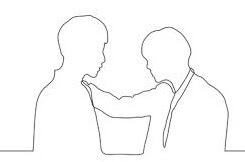Cooperative Approach to deal with equal power

A typical example could be your colleagues from different functions. They may have equal power and different goals even though they primarily work for the same organizational objectives.
Another example could be your business partner, who may have different views about the investment priorities or management approach.
In this relationship, neither constructive dominance nor compassion approach will not work, but a cooperative approach will work.
In a cooperative approach, we need to adopt perspective-taking, listening to other's concerns, acknowledging others, objectively backing our stand or views, and arriving at some third point solutions.
This approach will end up with win-win situations if anyone proactively manages the conflict considering the big picture of the organization or business goals.
Acknowledging other's views:
One of the qualities of influential people is they listen to other’s views and rephrase what they understood. They accept the diverse opinions of other people and acknowledge them. The benefit would be emotionally satisfying the other’s ego.
For example, if your counterpart or colleague says they can not fulfill your request to complete a task by a specified date as he/she has other priorities to complete and staff is overloaded etc. However you want it urgently, thereby conflict arises.
Here, you listen to their problems patiently (sometimes, complaints !) and acknowledging his/her issues which may be genuine. When you hear and recognize someone, that gesture puts the person in your comfort zone to work with you than against you. Emotionally, you are looking at other issues from their perspective.
Objectively backing your views :
When the other person is emotionally comfortable dealing with you, they are in a position to listen to your views. That is when you are stating your position with a logical perspective or with data points.
In the same example, when the person is in listening mode, you state your urgency to complete the task with a specified time with data points, explaining the purpose of the task and how important to you and the organization. That will impact the other person as they are emotionally and logically in line with your views. They are ready to help you or to arrive at some solutions along with you.
Arriving at some common ground :

In this stage, both are arriving at the solution favoring either one of you or arriving at the third angle solution approach to settle at the middle path.
In the above example, either the other person may agree to complete the task per your requirement, or you may arrive at some collaborative approach to make it happen either by providing additional resources or cutting down some of the scope or alternative timeline.
The key point is the responsibility of solving the conflict lies with the intelligent manager or the leader who wants to get the things done takes the lead in solving the conflict.
In today’s collaborative working environment, where cross-functional teams are involved in executing the task, one needs to learn to manage conflict through a cooperative approach.
Let us discuss some of the common approaches by influential leaders in solving the conflict by next week.




